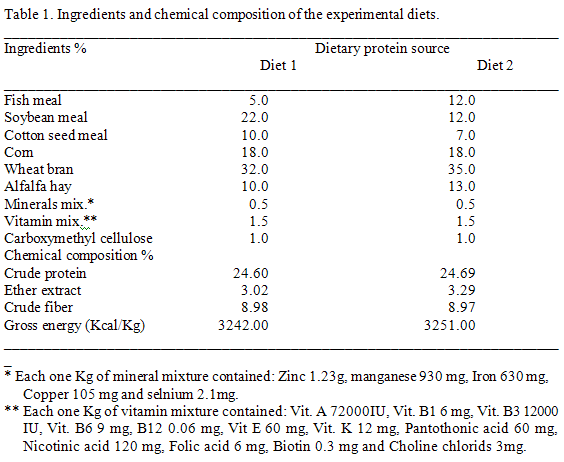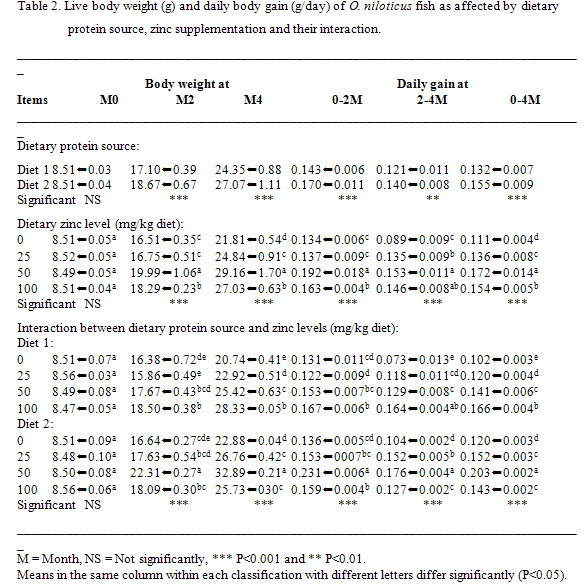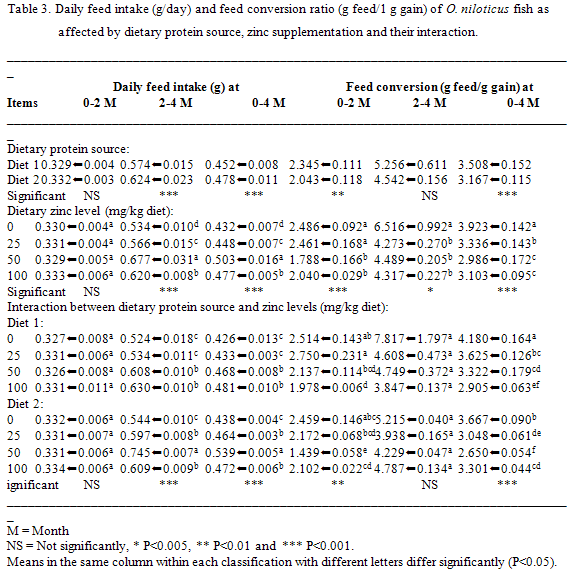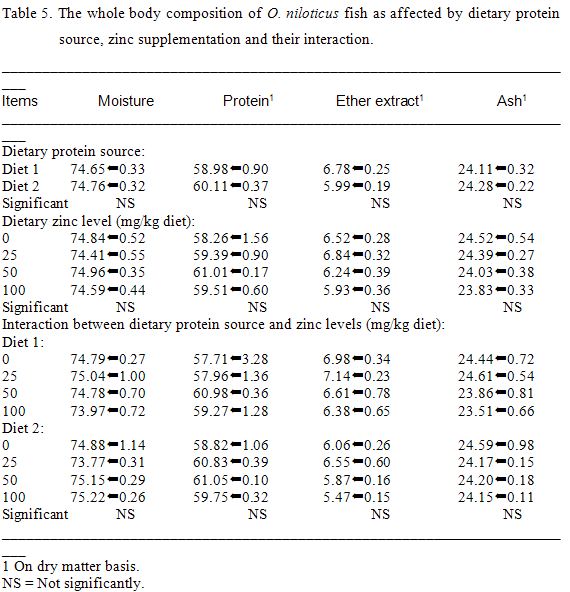Introduction
Aquaculture technology has evolved the push toward faster growth and higher production of fish has involved the enhancement or replacement of natural foods with prepared diets. Shiau et al. (1989) indicate that when dietary protein was suboptimal (24%), up to 67% of the fish meal protein in tilapia feeds can be replaced by soybean meal protein without any adverse effect on tilapia growth and feed conversion ratio. Also, Shiau et al. (1990) reported that the weight gain, feed conversion ratio, protein efficiency ratio and protein digestibility for fish fed on diets in which 30% of fish meal protein was replaced by defatted soybean meal or by full-fat soybean meal were not significantly different from those of fish fed on the control diet. The results suggest that either defatted soybean meal or full-fat soybean meal can be used to replace 30% fish meal protein in a diet for Oreochromis niloticus X O. aureus fingerling hybrids when the dietary protein level is low (24%). Omar (1994) noticed that the 1:1 mixture of the protein sources (fish meal and soybean meal) was superior to either of them given separately.
Zinc is an essential element many functions are recognized such as it is an essential part or a cofactor for a number of enzymes including carbonic anhydrase, carboxypeptidase, superoxide dismutase, lactate dehydrogenase, phosphatase and glutamate dehydrogenase (Prosser and Brown, 1966, Williams, 1969 and NRC, 1993). As a component of carbonic anhydrase, zinc playes a role in binding carbon dioxide in teleost cells, combining it with water to form carbonic acid and releasing carbon dioxide from capillaries at secondary lamellae of gills. Also, carbonic anhydrase is important in maintaining acid-base balance in renal tubule cells. As a cofactor of the protein-splitting enzyme carboxypeptidase, zinc has a key role in protein digestion (Sorensen, 1991). Fish accumulate zinc from both water and dietary sources; however, dietary zinc is more efficiently absorbed (Hardy et al., 1987). The zinc requirement of young rainbow trout and carp is 15 to 30 mg/kg of diet (Ogino and Yang, 1978 and 1979), wherease blue tilapia require 20 mg/kg of diet (McClain and Gatlin, 1988). Dietary protein source, phytic acid and form od zinc and calcium affect zinc absorption and use in fish (Hardy and Shearer, 1985, Wekell et al., 1986, Satoh et al., 1987 and 1989 and McClain and Gatlin, 1988). The bioavailability of zinc in fishmeal is inversely related to the tricalcium phosphate content. This is presumably caused by absorption of zinc into insoluble calcium phosphate complexes in the intestine that are passed through the gut unabsorbed and excreted (Satoh et al., 1987).
The objective of the present study was to investigate effects of fish meal level in the diets and zinc supplementation on growth performance, feed efficiency, blood components and body composition of young Nile tilapia fish.
Materials and methods
The study was conducted at the Department of Animal Production, Agriculture Faculty, Zagazig University. Young Nile tilapia averaged about 8.5 g were used in this study. The fish were stocked in twenty four glass aquaria (70 X 40 X 60 cm) supplied with fresh, aerated tap water. Fish were divided into eight groups, each group of fish was stocked into 3 aquaria and each contains 15 fish. The fish of the first four groups were fed the diet 1, which containing 15% of total crude protein from fish meal source and the other four groups were fed on the diet 2, which containing 35% of total crude protein from fish meal source (Table 1). The chemical compositions of the diets are shown in Table 1. Fish were fed one time daily at a feeding rate of 3% of body weight per day. The total duration of the experimental feeding trial was 4 months (from May to September, 2002). Within each dietary protein source, three fish groups were fed diets supplemented with vitamin zinc to supply 0, 25, 50 and 100 mg per kg diet. Fish wastes were siphoned out and 30% of the water in each aquarium was removed daily and replaced with fresh new water. Fish were individually weighed to the nearest 0.1 gm at the beginning of the experiment and biweekly intervals throughout the experimental period. Feed conversion was calculated as the quantity of feed required to obtain one unit growth during the experimental period, according to Berger and Halver (1987). Blood samples were taken from the caudal vein from randomly selected three fish in each group. The blood samples were centrifuged at 3000 RPM for 20 min. to separate the serum. Total protein, albumin, urea-N, creatinine and serum transaminase enzymes (AST; aspartate amino transferase and ALT; alanine amino transferase) were measured in blood serum by colormetric methods using commercial kits. Proximate chemical compositions of experimental diets and fish body were determined according to AOAC (1980).
The obtained data were statistically analyzed by 2 X 4 factorial experiment (Sendecor and Cochran, 1982) as the following model:
Yijk = µ + Si + Zj + SZij + Eijk
Where, µ is the overall mean, Si is the fixed effect of ith dietary protein source, Zjj is the fixed effect of jth dietary zinc supplementation level, SZij is the interaction effect of ith dietary protein source and jth dietary zinc level and Eijk is the random error. Differences between treatments were statistical tested by Duncan´s multiple range test ( Duncan, 1955).
Results and discussion
Growth performance:
Live body weight and daily growth weight of Nile tilapia fish increased significantly (P<0.001 or 0.01) with increasing fish meal in the diets (Table 2). Average final body weight and daily weight gain increased with 11.17 and 17.42% in fish fed the diet containing 35% of the dietary total protein from fish meal (Diet 2) than those fed the diet 1 which containing 15% of dietary protein from fish meal (Table 2). The obtained results are in agreement with Shiau et al. (1989 and 1990). Shiau et al. (1989) indicate that when dietary protein was suboptimal up to 67% of the fish meal protein in tilapia feeds can be replaced by soybean meal protein without any adverse effect on tilapia growth.
Live body weight and daily gain weight of Nile tilapia increased significantly (P<0.001) as affected with zinc supplementation in the diets (Table 2). Average final body weight increased with 13.89, 33.70 and 23.93%, respectively, in fish fed diets supplemented with 25, 50 and 100 mg zinc/ kg of diet than those fed diets without zinc supplementation. The same figures for daily gain weight were 22.52, 54.95 and 38.74%, respectively (Table 2). Fish group fed the diets supplemented with 50 mg zinc/kg diet recorded higher final body weight and daily gain weight (P<0.05) than the other groups. The significant improvement in growth performance of fish fed diets supplemented with zinc up to 50 mg/kg diet may be attributed to the sufficient zinc to Increase the activity of enzymes of zinc-rnetaIloenzynes, which stimulate the synthesis of body protein and improvement of growth rate (Riorden and Vallee, 1976 and Freeman 1983). Sorensen (1991) reported that, as a cofactor of the protein-splitting enzyme carboxypeptidase, zinc has a key role in protein digestion.
The interaction between dietary protein level and zinc supplementation significantly (P<0.001) affected live body weight and daily body gain (Table 2). Within the diet 1, fish group fed diet supplemented with 100 mg zinc recorded higher final body weight or growth rate (P<0.05) than the other groups. However, within the diet 2, fish group fed diet supplemented with 50 mg zinc recorded higher final body weight or growth rate (P<0.05) than the other groups. The obtained results indicated that the increasing of fish meal in the diet reduced effects of the zinc. The bioavailability of zinc in fishmeal is inversely related to the tricalcium phosphate content. This is presumably caused by absorption of zinc into insoluble calcium phosphate complexes in the intestine that are passed through the gut unabsorbed and excreted (Satoh et al., 1987). Barker and Halpin (1988) indicated that soybean meal, corn or wheat brain, which are major ingredients of fish diets are rich in phytate content that have an antagonistic effect on the available zinc.
Feed efficiency:
Increasing fish meal in fish diet increased the feed intake (P<0.001) and improved the feed conversion (P<0.001) during the whole experimental periods (Table 3). Feed conversion improved by 9.72% in fish group fed diet 2, which containing 35% of the dietary total protein from fish meal (Diet 2) than those fed the diet 1, which containing 15% of dietary protein from fish meal (Table 3).
Zinc supplementation in Nile tilapia fish diets increased feed intake and improved feed conversion during the whole experimental period (0-4 months). Fish fed the diets supplemented with 50 mg zinc/kg diet recorded the best feed conversion (P<0.05) than the other experimental groups (Table 3). Feed conversion improved by 14.96, 23.88 and 20.90%, respectively, in fish fed diets supplemented with 25, 50 and 100 mg zinc/ kg of diet than those fed diets without zinc supplementation. Such significant improvements in feed conversion are due to that zinc is essential in metabolism (Banerjee, 1987)
The interaction between dietary protein source and zinc supplementation affected significantly (P<0.001) daily feed intake or feed conversion during the whole experimental period (0-4 months). Within the diet 1, fish group fed diet supplemented with 100 mg zinc recorded the best feed conversion (P<0.05) than the other groups. However, within the diet 2, fish group fed diet supplemented with 50 mg zinc recorded the best feed conversion (P<0.05) than the other groups.
Blood components:
Serum total protein, albumin, and AST (as indicator of liver function) significantly (P<0.01) increased with increasing fish meal in fish diet, while urea-N and ALT significantly (P<0.001 or 0.05) decreased. On the other hand, serum creatinine concentration insignificantly affected with protein source in fish diet (Table 4).
All blood components affected significantly (P<0.001 or 0.05) with zinc supplementation in fish diets. Serum total protein, albumin, creatinine and AST significantly (P<0.001 or 0.05) increased with increasing zinc level in fish diet, while ALT significantly decreased (Table 4). Fish group fed diets supplemented with 50 mg zinc/kg diet recorded higher serum albumin concentration. Increasing serum total protein and AST concentrations may be attributed due to the increasing of protein syntheses in the liver and related with improved the metabolism rate.
The interaction between dietary protein source and zinc supplementation significantly (P<0.001 or 0.05) affected serum total protein, albumin, urea-N and AST (Table 4). Within the diet 1, fish group fed diet supplemented with 100 mg zinc recorded higher concentration of each serum total protein, albumin, urea-N and AST than the other groups. However, within the diet 2, fish group fed diet supplemented with 50 mg zinc/kg diet recorded higher concentration of each serum total protein, albumin and AST than the other groups.
Body composition:
Fish body composition did not affect significantly with dietary protein source, dietary zinc supplementation or the interaction between them (Table 5).
In conclusion, supplementation fish diets with 50 mg zinc/kg diet could be recommended, since it showed the highest final weight and body gain weight and the best feed conversion. However, when the fish meal in the diet was reduced may be increased the level of zinc supplementation up to 100 mg.
REFERENCES
AOAC (1980). Official Methods of Analysis, 13th Edition. Association of Official Analytical Chemists, Virginia.
Baker D.H. and Halpin K.M. (1988). Zinc antagonizing effects of fish meal, wheat bran and corn-soybean mixture when added a phytate and fibre-free casein-dextrose diet. Nutrition Research, 8: 213-218.
Banerjee G.C. (1987). Animal Husbandry. 6th Edition, Published by Mohan Prinzlani, Oxford.
Berger A. and Halver J.E. (1987). Effect of dietary protein, lipid and carbohydrate content on the growth, feed efficiency and carcass composition of striped bass (Morone saxatitis) fingerlings. Aquaculture, 18: 345-356.
Duncan, D.B. (1955). Multiple range and multiple F-test. Biometrics, 11:1-42.
Freeman B.W. (1983). Physiology and Biochemistry of the Domestic Fowl. 4th Eddition, Academic Press, p. 181, New York and London.
Hardy R.W. and Shearer K.D. (1985). Effect of dietary calcium phosphate and zinc supplementation on whole body zinc concentration of rainbow trout (Salmo gairdneri). Candian Journal of Fishery Aquatic Science, 42: 181-184.
Hardy R.W. Sullivan C.V. and Koziol K.M. (1987). Absorption, body distribution and excretion of dietary zinc by rainbow trout (Salmo gairdneri). Fish Physiology and Biochemistry, 3: 133-143.
McClain W.R. and Gattin D.M. (1988). Dietary zinc requirement of Oreochromisaureus and effects of dietary calcium and phytate on zinc bioavailability. Journal World Aquaculture Science, 19: 103-108.
NRC (1993). Nutrient requirements of fish. National Academy Press, Washington, D.C.
Ogino C. and Yang G.Y. (1978). Requiremnet of rainbow trout for dietary zinc. Bull. Jpn. Soc. Sci. Fish., 44: 1015-1018.
Ogino C. and Yang G.Y. (1979). Requiremnet of carp for dietary zinc. Bull. Jpn. Soc. Sci. Fish., 45: 967-969.
Omar E.A. (1994). Supplementary feeding of tilapia (Oreochromis niloticus) cultured in earthen ponds. 1. Effect of dietary protein levels and sources. Alexandria Journal of Agricultural Research, 39 (2): 109-128.
Rirodan J.F. and Vallee B.L. (1976). Trace elements in human health and disease. Structure and function of zinc metalloenzymes. Academic press, New York, London, pp. 227-256.
Satoh S., Poe W. and Wilson R.P. (1989). Effect of supplemental phytate and/or tricalcium phosphate on weight gain, feed efficiency and zinc content in vertebrae of channel catfish. Aquaculture, 80: 155-161.
Satoh S., Takeuchi T. and Watanbe T. (1987). Availability of rainbow trout of zinc contained in white fish meal and various zinc compound. Bull. Jpn. Soc. Sci. Fish., 53: 595-599.
Shiau S.Y., Kwok C.C., Hwang J.Y., Chen C.M., and Lee S.L. (1989). Replacement of fishmeal with soybean meal in male tilapia (Oreochromis niloticus X O. aureus) fingerling diets at a suboptimal protein level. Journal of the World Aquaculture Society, 20 (4): 230-235.
Shiau S.Y., Lin S.F., Yu S.L., Lin A.L. and Kwok C.C. (1990). Defatted and full-fat soybean meal as partial replacement for fishmeal in tilapia (Oreochromis niloticus X O. aureus) diets at low protein level. Aquaculture. 86 (4): 401-407.
Snedecor, G.W., Cochran, G.W. (1982). Statistical methods. 6th edition. The Iowa State University, Press Ames, USA.
Sorensen Elas M.B. (1991). Metal Poisoning in Fish. CRC Press Inc., 2000 Corporate Blvd., N.W., Boca Raton, Florida, 33431, Library of Congress Card Number 91-7175, USA.
Wekell J.C., Shearer K.D. and Cauglitz Jr. E.J. (1986). Zinc supplementation of trout diets: Tissue indicators of body zinc status. Progress Fish Culture, 48: 205-212.











.jpg&w=3840&q=75)